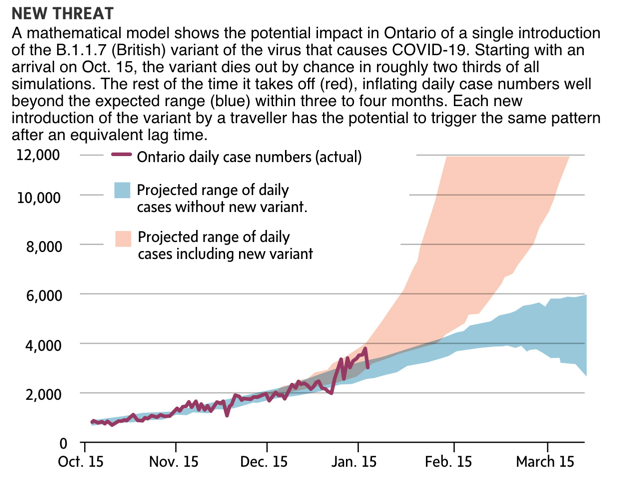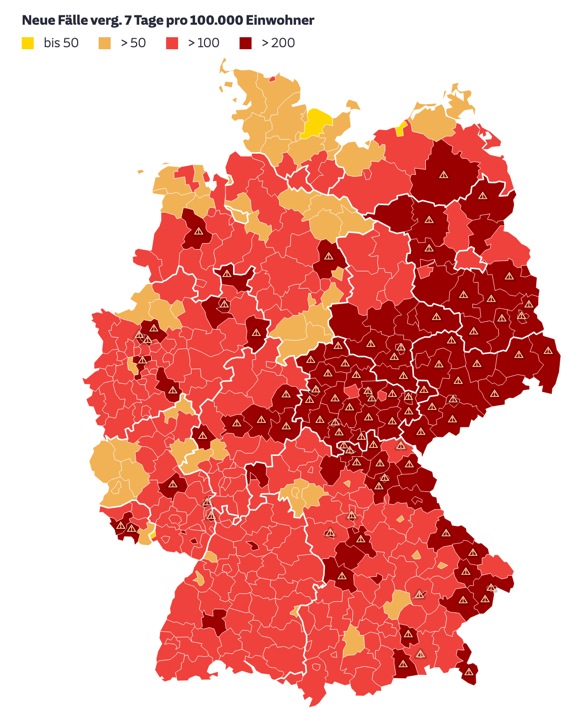Some thoughts on this latest wave of coronavirus
While job losses may be the norm for the next few months, I have actually been somewhat encouraged by data out of the US. That was the macro takeaway from my last piece.
The problem is and has always been the pandemic, particularly for the US, given its poor ranking among developed countries in minimizing infection and death. So I want to talk a little about what I’m seeing, in part spurred by two articles, one in a Canadian newspaper and the other in a Swiss one.
Let’s start in Canada.
How to think about mutant strains
Before I begin, I will preface this with my usual proviso that I am not an epidemiologist. So, I am really trying to translate credible epidemiological information into a reasonable range of economic outcomes. And the Canadian experience highlighted in Ontario below speaks to why I am downbeat about growth.
Here’s the important bit:
Ontario is bracing for a perilous inflection point in the COVID-19 pandemic, which a mathematical model projects could result from a new variant of the virus that is showing up in the province.
According to the projection, released during a news briefing on Tuesday, the variant is poised to rapidly inflate case numbers and overwhelm emergency rooms in the province based on its behaviour in other locations. The projection helps explain why Ontario has issued a provincewide stay-at-home order beginning Thursday.
The more infectious variant of the coronavirus they are discussing is the one first spotted in the UK that has caused a massive second wave there and led to lockdowns. Canadian scientists estimate that having the B117 variant ‘take over’ will see caseloads go from doubling every 45 days today to doubling every ten days – without a diminution in the lethality of the virus. That would lead to the healthcare system collapsing under the strain. This chart encapsulates the problem.

When do infectious mutant strains take over?
An epidemiological model suggests “the “takeoff” generally occurs at three to four months. At that point the variant begins to quickly outpace the older version of the virus and causes a rapid escalation in total case counts. If there was such an October introduction, that would mean the variant would be starting to have a significant effect now.”
The Swiss story on this speaks to how little data there is on virus variants (article in German here). The UK and Denmark are the only two European countries that do significant genetic testing of virus infections. And the Swiss talk about a 501Y.V2 variant discovered in South Africa and the B117 variant discovered in the UK as being significantly more infectious.
Here’s a translation of the bit that caught my eye:
Based on the investigative data, it is clear that the new variants are increasing: According to the BAG, they made up 0.4 percent of positive samples in week 52 [of 2020] and 1.4 percent in the first week of this year. Since it takes about 10 to 14 days for the results of the sequencing, about 5 to 6 percent of the cases in Switzerland are likely to have been caused by the new variants.
What they’re telling you is that new more infectious coronavirus variants are quickly supplanting the older variants in Switzerland as well as in Canada. We should therefore expect more infections. And with the lethality not diminishing, more hospitalization and death. And we should expect this to occur everywhere. Just as the virus spread everywhere from China in late 2019 and early 2020, the new mutant strains have been spreading everywhere in late 2020 and early 2021. The WHO reports that the B117 variant has been reported in 50 countries and the South African variant in 20. Eventually, I believe evidence suggests they will take over.
Hospital overloads
The reason this is significant is that it takes an already stressed healthcare system to a point where economy-busting lockdowns are inevitable. And a recent Twitter thread by an MD highlights how this occurs. He talks of COVID cases overwhelming ICUs and forcing a rationing of care. His view is that leads to excess mortality above and beyond the deaths directly attributable to the virus. He writes:
Years from now, careful analysis will likely find that during this time, sick people without COVID in hot spots died at much higher rates
That’s what happens when hospitals become strained
Their deaths won’t count as a COVID-related deaths
But may be, it should
Fin
— Ashish K. Jha, MD, MPH (@ashishkjha) January 13, 2021
And remember that just today the US showed a record 4,406 deaths from the virus.

Implications?
For me, this suggests that we are entering a very dark winter indeed. And I don’t think this has dawned on people.
For example, to the degree that the B117 variant is already rife in the US, the storming of the Capitol in DC on Jan 6 is a superspreader event because maskless people from everywhere across the country converged on one location and then dispersed to the various parts of the country from which they came, seeding infection in those communities.
Look at the scenes in Tuscaloosa, Alabama after the University of Alabama won the College Football Championship game. Even CBS News is calling it a likely superspreader event. And, of course, we already know holiday travel contributed to viral transmission. All of this is going on while more transmissible strains of COVID-19 are likely in circulation.
For the US, then, the implication of what has happened in the UK and the viral spread that Canada and Switzerland are talking of is that we are going to see a severe situation by early February. That’s my takeaway. Again, I am not an epidemiologist. But, the logic is clear. You don’t have to know the science to see the causal chains. And, of course, since the US healthcare system is already stretched, that will lead to economic disruptions.
Interestingly, though, I think the willingness of state and local officials in the US to lock down has diminished significantly. So, while there will be disruption, it will likely not be as all encompassing as it was in March and April 2020. We’ll see.
Germany
I have a few odds and ends to report and I want to end this with Germany because that’s an interesting case for me in all of this.
Central Europe is being overrun by coronavirus right now. It’s to the point that Austria has today just closed 45 border crossings with the Czech Republic and Slovakia because of infections there. And in Germany, we see the impact because of the massive increase in infections in Eastern Germany. Look at this chart of infections, with the redder regions the worst.

Source: Sueddeutsche.de
None of the regions where infection was worse in the Spring or Fall are in the deep red. Instead, what I see is regions that were less hard hit – and closest to the rest of central Europe – being pummeled by coronavirus.
This is a country that was lauded for its coronavirus approach in the Spring. And yet, here we are with more than 1000 deaths in Germany in the last 24 hours. That’s the equivalent of 3,000 deaths in the US, a level of the same order of magnitude as we see in the US.
My take
So, going back to how I started this, the economy is going to suffer in this situation. I know a vaccine is coming. We still have a long way to go before we get to the other side of this thing. And I learned over the weekend that a friend’s mother was admitted to the hospital and is now intubated because of Covid-19. The prognosis is poor. It’s bitter because she just needed a few weeks maybe and she could have been vaccinated.
Personally, I have cabin fever. I am sick of this crisis. But I know I have to ride it out because the worst is yet to come. I reckon a lot of people feel the way I do about things. And so, they are taking risks. And that means and has meant greater spread. We have to be concerned about our most vulnerable, like my own mother. But the question now is also how our most economically vulnerable survive.
My hope is that the Biden Administration corrects the incoherent coronavirus policy of the Trump Administration and puts the US back on the right footing. Germany shows you that even competent responses won’t allow you to escape Scot-free. But with a less porous social safety net, a coherent federal level policy and an effective vaccine rollout, we can minimize the damage. That’s true no matter what country you live in.
Take care and stay safe.
Comments are closed.